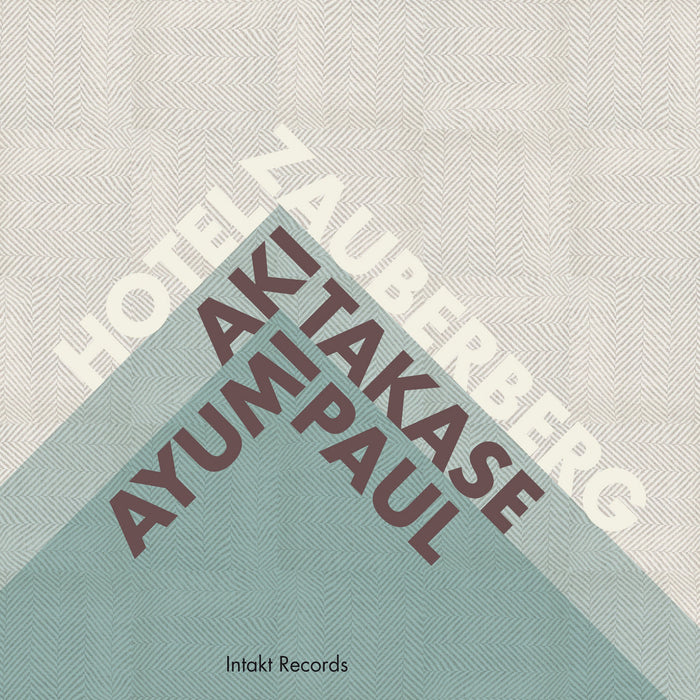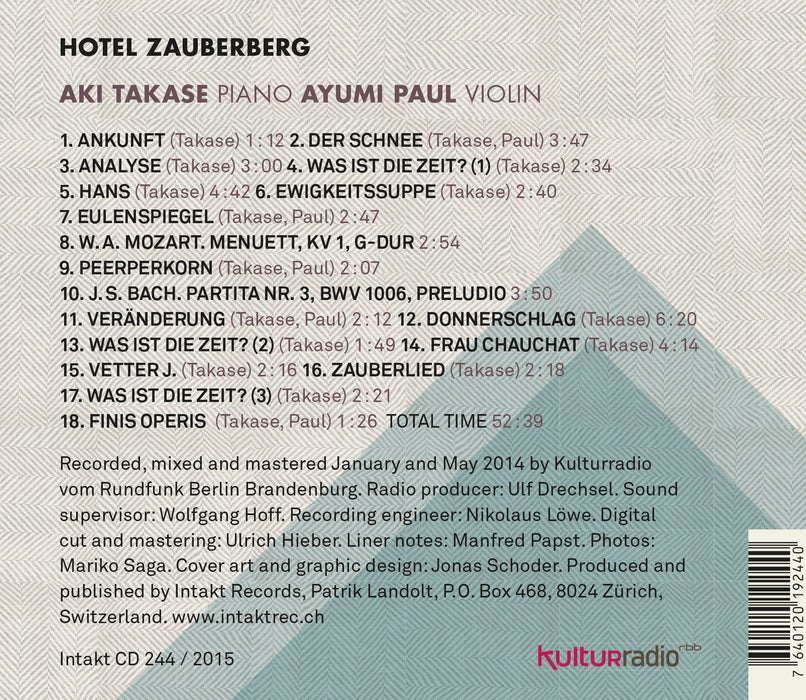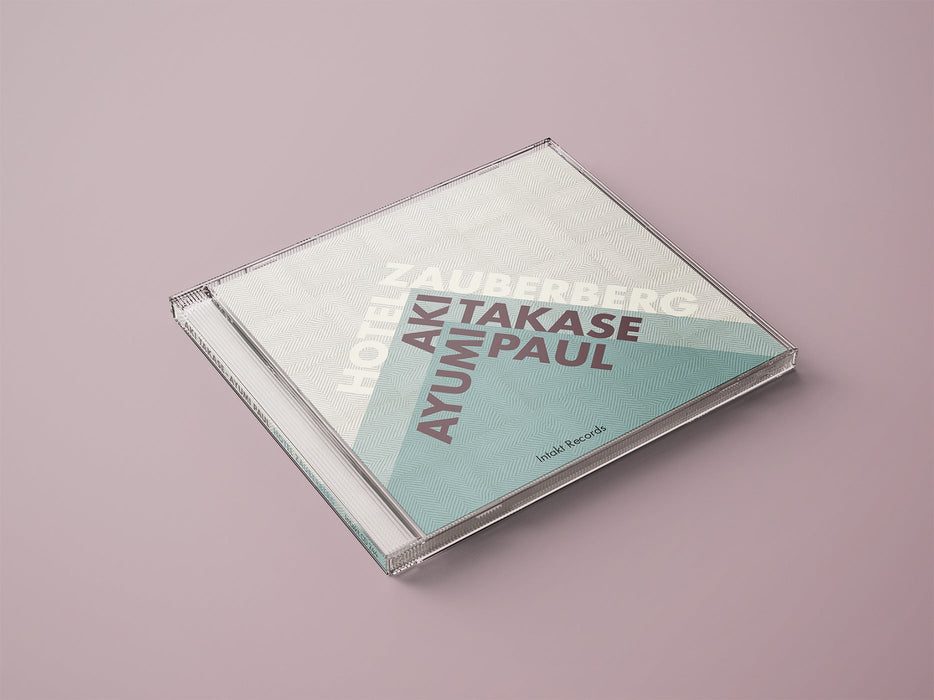


244: AKI TAKASE – AYUMI PAUL. Hotel Zauberberg
Intakt Recording #244 / 2014
Aki Takase: Piano
Ayumi Paul: Violin
Recorded, mixed and mastered January and May 2014 by Kulturradio vom Rundfunk Berlin Brandenburg.
More Info
The project ‘Hotel Zauberberg’ arose out of Aki Takase’s and Yumi Paul’s shared admiration for the writer Thomas Mann. It mostly consists of notated compositions, with some improvised parts as well. Eleven of the eighteen pieces were penned by Aki Takase, another five are collaborations with Ayumi Paul. Additionally, there are adaptations of a Mozart Minuet and a Bach Partita.
Aki Takase reacts to the polyphony of the novel with a variety of stylistic elements. She has never been a purist anyway; she’s never been shy of contact. She is an avant-gardist drawing on tradition. She’s got both claws and finesse.And, most of all, she’s got a sense of humour.
Aki Takase and Ayumi Paul’s first collaboration stands out through its light-footed intelligence as well as a sense of the abysses of the ‘Magic Mountain’, which turns into a world-theatre of love, illness and death. Thomas Mann, whose work includes music as a subject in itself as well as a language, would have enjoyed it.
Album Credits
Cover art and graphic design: Jonas Schoder
Liner notes: Manfred Papst
Photo: Mariko Saga, Vanessa Franklin
Recorded, mixed and mastered January and May 2014 by Kulturradio vom Rundfunk Berlin Brandenburg.
Radio producer: Ulf Drechsel. Sound supervisor: Wolfgang Hoff. Recording engineer: Nikolaus Löwe. Digital cut and mastering: Ulrich Hieber.
Produced and published by Intakt Records, Patrik Landolt
Ascoltare la pianista nipponica Aki Takase è sempre una esperienza foriera di sorprese, grazie ad una creatività e disposizione al rischio davvero rare. Lo spirito avventuroso della sua composita cifra artistica ben si sposa con lo spirito esplorativo della label che ha prodotto questo sinestetico progetto, fra suggestioni sonore e letterarie.
L'idea è quella di trasporre sul piano musicale la storia ed i personaggi del massimo capolavoro di Thomas Mann, "La montagna incantata." Aleggia così sul progetto l'aura musicale austro-germanica tanto amata dallo scrittore ed in particolare il riadattamento per pianoforte di temi bachiani e mozartiani. Il tutto viene intriso non di estetica jazzistica, ma di retaggio classico euro colto contemporaneo.
Piano e violino eseguono per lo più rigorosamente parti scritte, debitamente soggette a variazioni estemporanee. Il duo dà così vita ad un percorso musicale ispirato, suggestivo e coinvolgente per esaltare tutta la ricchezza timbrica degli strumenti impiegati. I lettori si chiederanno a questo punto cosa c'è di jazzistico in questo CD. La risposta risiede nella variazione continua della spazialità, del colore e della dinamica sonora da parte della Takase.
https://www.allaboutjazz.com/hotel-zauberberg-aki-takase-ayumipaul-intakt-records-review-by-maurizio-zerbo
La pianiste Aki Takase dialogue, quant à elle, avec le violoniste Ayumi Paul, qui travaille habituellement dans le champ classique et contemporain. L'atmosphère de leur disque se situe dans un esprit très "milieu du XXe siècle". Ainsi sont évoqués Satie ou Stravinsky, mais Bach et Mozart ne sont pas oubliés non plus. Mais qu'on ne s'y méprenne pas, il s'agit de création musicale, et de la plus belle manière qui soit : « Hotel Zauberberg »
http://www.culturejazz.fr/spip.php?article285
Resistenze radicali
Anelli di resistenza al luogo comune mai concilianti, prendere o lasciare. Cosi si potrebbero definire le uscite dell'etichetta svizzera Intakt, che continua a documentare su cd istanze radicali del jazz europeo, non disdegnando di gettare un orecchio anche oltre oceano, dove il free jazz è ben più vivo di quanto vorrebbero farci credere. Di sicuro Alexander von Schlippenbach al pianoforte, Evan Parker al sax tenore e Paul Lovens alla batteria usata come set percussivo a tutto campo, la banalità la sfuggono come la peste. Nel set documentato su Features non aspettatevi solo torridi e incendiari muri di suono improvvisato, ma anche giochi di incastri col silenzio di gran gusto, quasi uno scheggiato percorso melodico. Un altro pianoforte assai radicale, quello della giapponese Aki Takase incontra il violino eccellente di Ayumi Paul in Hotel Zauberberg, sorta di tributo per pannelli musicali diversi allo scrittore Thomas Mann. Curiosamente tornano gli alberghi in un altro bel titolo Intakt: Hotel Grief del batterista Tom Rainey, dal vivo con Ingrid Laubrock ai sax e Mary Halvorson alla chitarra.
Memorable recordings in 2015
2015 was the year of my sharpest departure from the nominations for the GRAMMY awards. My assessment article about those nominations revealed a generous amount of overlap with recordings that had been discussed on this site; but, since my criteria for this particular article involves the memorability of my listening experiences, I was more than a little dejected to realize that I could only recall what I had written about most of those recordings with the aid of a search engine. Indeed, the most vivid memory did not involve a nomination for a recording. Rather it was the nomination for producer Judith Sherman, one of whose projects in 2015 was Anthony de Mare's recording Liaisons: Re-Imagining Sondheim from the Piano. While I would not begrudge Sherman her nomination, my personal memories were primarily of de Mare and his project, rather than the production work behind the album.
Indeed, much of what was memorable as I skimmed the headlines of my articles on this site involved what might be called "imaginative rethinking," exercised in a variety of different domains. Most imaginative of all may have been Zoë Black, Assistant Leader of the Australian Chamber Orchestra. She asked jazz pianist Joe Chindamo to add a violin line to Johann Sebastian Bach's BWV 988 set of 30 variations on an aria best known as the "Goldberg" variations. Chindamo clearly knew his Bach very well; and, more specifically, he knew how to think about each of Bach's variations as a contrapuntal fabric involving two or more voices. It is not too hard to imagine Bach himself presenting one of his students with a sample of counterpoint and challenging that student to add another line; so, from that point of view, Chindamo was basically a Bach student separated from the master by several centuries.
The results were released on a recording entitled The New Goldberg Variations. One has to listen to only the first few variations to appreciate that Chindamo's efforts were anything but a clever parlor trick. Even if not all of the notes were written by Bach himself, this album is more about Bach than many of the recordings of BWV 988 made by ostensibly more "serious" pianists.
An entirely different approach to rethinking can be found in a new Intakt album of jazz pianist Aki Takase released this past February. The title of the album is Hotel Zauberberg; and it basically amounts to using the time-based medium of making music to consider the extent to which Thomas Mann's novel The Magic Mountain is a story about time itself. The result is an eighteen-movement suite for violin and piano with eleven movements written by Takase and five written collaboratively with violinist Ayumi Paul. The remaining two movements are Wolfgang Amadeus Mozart's K. 1 minuet in G major and the Preludio movement that begins Johann Sebastian Bach's solo violin partita in E major (BWV 1006).
I have to confess that, while all of my other Takase albums sit very comfortably in my jazz section, I felt the only appropriate place for this one was in my classical section, where she could rub shoulders comfortably with Toru Takemitsu. I was not surprised that the GRAMMY judges did not know what to make of the album; but, in my book, this was one of the most absorbing recordings of recently composed music that I encountered in 2015. I hope that Takase and Paul can take this on the recital circuit and bring this music to concert stages in the United States. When it comes to original composition, this music scales a very high bar.
Another new approach to composition could be found on the new MicroFest Records label. MicroFest calls itself "The world's premier festival of microtonal music." It was founded in 1997 by John Schneider and is co-directed by Schneider, pianist Aron Kallay, and composer Bill Alves. One of the first releases on this label was an album of two compositions for violin and gamelan by Alves entitled Mystic Canyon. Alves was far from the first to explore the microtonal possibility of a violin playing in a gamelan setting. Lou Harrison is probably his best known predecessor. However, each of the two compositions on Mystic Canyon has a distinctively unique voice that would not be confused with the work of other composers drawn to Javanese music. This music becomes fixed in memory because lends itself to repeat listening experiences.
However, where modernism is concerned, the "mother lode" for 2015 would have to be all the attention doled out to Pierre Boulez. Most important was the decision of Universal Music Classics to release a ten-CD anthology of the Domaine musical performances performed and/or organized by Pierre Boulez between 1956 and 1967. In many respects this was a crucible of modernism in the decades following the end of the Second World War. As interesting as the studied but always expressive performances in this collection is the scope of repertoire that spans from Arnold Schoenberg through Igor Stravinsky (particula...
È traendo maggior ispirazione dal romanzo La montagna incantata di Thomas Mann (Der Zauberberg, in originale) che s’instaura un’ennesima collaborazione inedita, tra il pianoforte e le invenzioni di Aki Takase, performer nippo-germanica di primaria statura nel free odierno, e la violinista di formazione classica Ayumi Paul, di analoga doppia nazionalità e di successiva generazione, egualmente sperimentata su versanti pop ed aperta sui fronti delle avanguardie.
La «catturante musicalità del linguaggio di Thomas Mann» nell’originale, secondo la lettrice ed estimatrice Aki Takase, insieme ad un peculiare senso narrativo del tempo, ha indotto l’urgenza di realizzarne una versione in forma di suite, con miniature in musica dell’amalgama dei personaggi e del locale paesaggio invernale, opponendo «alla polifonia del romanzo una varietà di elementi stilistici: per lo più composizioni scritte, ma con spazio per parti improvvisate, aggiungendo adattamenti di un Minuetto mozartiano e una Partita di Bach.»
Hotel Zauberberg svela le sue radici classiciste piuttosto letterali già in Ankunft, incipit che elabora a parti bilanciate le intense dinamiche della sonata barocca, trattando con asperità d’accenti il non evidentemente placido tempo di minuetto (W. A. Mozart Menuett), quindi l’assai più dissonante e livido Peerperkorn è anticamera delle libere folate aeree nella Partita nr. 3, letterale esecuzione da Johann Sebastian Bach.
S’avvicendano la spedita corrente umoristica di Analyse, caricaturale e grottesca, l’intensa e alienante ieraticità in Eulenspiegel, le ipnotiche frenesie di Ewigkeitssuppe, il brulicante incrocio di “tipi” umani di Donnerschlag, uggiosità e languori “tangueros” in Frau Chauchat.
Serena l’esposizione del motivo romantico in Zauberlied, che scioglie le cornici della tripartita Was ist die Zeit?, passaggio emotivo di ispirata, elegante atonalità, dilagando le tensioni del dialogo musicale nell’epilogo Finis Operis, che catalizza le pervasive correnti in spirito free del lavoro.
Temperato e intrigante ibrido stilistico, in cui il portato letterario della fisiologia classicista dei due strumenti, del tutto liberi peraltro di devolversi alla forma libera, il cameristico Hotel Zauberberg è improntato da materiali e sensibilità euro-centrici, sotto la lente deformante di un citazionismo colto e talvolta caustico, è cursus musicale che rigenera con creativa intelligenza i climi dei rivolgimenti formali e personologici del primo Novecento, mai appannato per fascino e deviazioni. Assai più rigoroso e formale nel trattamento dei materiali del passato rispetto a coppie alla Guy-Homburger, ad esempio, il duo palesa un relativamente poco praticato idioma a piste parallele, che mantiene eloquenti e vitali le correnti interne, non prive di turbolenze e increspature, delle culture del vecchio continente, segnatamente a partire da un culto dei “classici” evidentemente non antitetico alla ricerca individuale e alla crescita formale.
https://www.jazzconvention.net/2015/08/07/aki-takase-a-ayumi-paul-hotel-zauberberg/
Nachdem die japanische Pianistin Aki Takase mit ihrem Mann Alexander von Schlippenbach Thomas Manns Jahr- hundertroman „Der Zauberberg" (1924) in der Originalsprache (!) gelesen hatte, wuchs in ihr der Wunsch, ihrer Bewunderung für diesen Roman musikalischen Ausdruck zu verleihen.
Als Partnerin für dieses Projekt fand sie die japanisch-deutsche Violinistin Ayumi Paul, die sie bereits 2011 kennengelernt hatte. Die Handlung des Romans - quasi ein Anti-Entwicklungsroman, weil die Protagonisten in der morbiden Weltabgewandtheit des mondänen Lungensanatoriums in Davos nicht das Leben, sondern der Tod erwartet - ist kurz vor dem Beginn des Ersten Weltkrieges angesiedelt. Wie Thomas Mann seine Romane wie groß angelegte Musikstücke komponieren wollte, so gingen Aki Takase und Ayumi Paul daran, Literatur musikalisch zu durchdringen. In 18 Stükken, zumeist aus der Feder von Aki Takase, reflektierten sie Situationen und Figuren des Romans, philosophische Gespräche und die alpine Natur, nicht aber narrativ, als musikalische Nacherzählung, sondern indem sie versuchten, den Geist, das Essenzielle dieser bürgerlichen Anarcho-Idylle musikalisch einzufangen. Thomas Manns Reflexionen über die Funktion der Zeit, bzw. über deren Auflösung in der Weltabgeschiedenheit, die im Roman eine große Rolle spielen, gerin- nen bei Takase und Paul in drei musikalischen Reflexionen über die Zeit, die auch eine immanent musikalische Bedeutung gewinnen. Entsprechend ist ihre Musik auch ein Spaziergang durch die Musikgeschichte, denn Anspielungen an Schönberg stehen gleichberechtigt neben bürgerlichen Idyllen und Folklore, Tangos und stampfenden Polkas. Durchkomponierte Stücke und Improvisationen wechseln sich ab, es tauchen sogar zwei Bearbeitungen klassischer Kompositionen auf: Mozarts Menuett KV1 und Bachs hervorragend gespielte Violinpartita BWV 1003. Den beiden ist ein Stück Kammermusik von großer Eindringlichkeit gelungen, Musik, die interpretiert und kommentiert, aber selbst auch den Hörer zum Interpretieren einlädt. Sie reflektieren mit ihrer Musik Widersprüchlichkeit und Brüchigkeit des bürgerlichen Selbstbildes, meist ironisch, manchmal auch tragisch - der Ironiker Thomas Mann hätte mit Sicherheit seinen Spaß daran gefunden.
Literarisch gibt sich die höchst aktive japanische Pianistin mit Wohnsitz Berlin, Aki Takase, auf ihrer Duo-CD mit der Geigerin Ayumi Paul. Thomas Manns Jahrhundertroman Der Zauberberg ist der rote Faden durch den bei Intakt erschienenen Tonträgers. Ähnliches hat vor einigen Jahren Simon Nabatov mit Michail Bulgakows Der Meister und Margarita versucht. Musikalisch wirkt das Konglomerat aus Improvisation, der Reflexion so manches Zeitgenössischem und der barocken Strenge eines Johann Sebastian Bach zuweilen ein wenig spröd. Bach kommt auch sehr direkt zu Wort mit dem Preludio zur dritten Partita, Ayumi Paul spielt das sehr klassisch, ebenso wie Takase das Mozart-Menuett, das in Österreich bekannt wie ein Schlager ist und so ein wenig aus dem durchaus innovativ zu nennenden Konzept fällt. So werden immer wieder schöne Bezüge zum Buch hergestellt, Figuren herausgenommen, wie Hans Castorp oder Madame Chauchat, über die Zeit philosophiert. Es gibt ganz grandiose musikalische Momente zwischen der Ankunft am Beginn und dem Finis Operis am Ende. Das folgt präzise Thomas Mann und macht Lust, das Buch wieder einmal zur Hand zu nehmen.
"Leichtfüssige Intelligenz, aber auch Sinn für die Abgründe des 'Zauberbergs', der zum Welttheater von Liebe, Krankheit und Tod wird, zeichnen die erste Gemeinschaftsarbeit von Aki Takase und Ayumi Paul aus. Thomas Mann, in dessen Werk die Musik als Thema, aber auch als Sprache allgegenwärtig ist, hätte seine Freude gehabt." Die Liner Notes von Manfred Papst bringen auf den Punkt, was dieser CD innewohnt. Der sie geschrieben hat, ist einer der kompetentesten Kulturkenner und -beschreiber im Land, Ressortleiter Kultur der NZZ am Sonntag und als Vorstandmitglied der Thomas Mann-Gesellschaft wie wenige zu dieser Einschätzung berufen. Takase durften wir zuletzt im Trio mit Sclavis-Courtois-Pifarély bewundern, hier und mit dieser Partnerin legt die seit 1987 in Berlin lebende japanische Jazzpianistin kammermusikalisch noch zusätzlich ein Scheit ins Feuer: Das dürfte ein wenig dem "Zauberberg" zuzuschreiben sein, kaum aber der abgeschlossenen Welt des Davosers Sanatoriums am Vorabend des ersten Weltkriegs. Entscheidend hängen die Intensität der wechselvollen Musik, die Spannung, von der sie lebt, die Farbtöne, die sie aufblitzen lässt, die stimmigen, stringenten Bilder, die sie hervorruft, mit der experimentierfreudigen klassischen Geigerin und dem mit ihr möglichen Dialog zusammen. Die wohl improvisatorisch entstandenen elf Kompositionen Takases und die fünf gemeinsamen werden ergänzt mit Bearbeitungen eines Mozart-Menuetts und einer Bach-Partita.
Thomas Manns „Zauberberg" als Anstoß für einen Zyklus aus knapp 20 Musikminiaturen, zum Leben erweckt von der in Berlin lebenden japanischen Pianistin Aki Takase und der deutsch-japanischen Violinistin Ayumi Paul. Die beiden Künstlerinnen halten sich nicht strikt an die Handlung der Romanvorlage, sondern versuchen mit einer breiten Palette an Stilmitteln die Stimmung des „Welttheaters von Liebe, Krankheit und Tod" (so der Schweizer Journalist Manfred Papst in den Liner Notes) musikalisch nachzuempfinden. Das reicht von strengen Kammerstücken, die an Bach'sche Inven. tionen erinnern, über impulsiv-hingehämmerte und -gekratzte Skizzen, bei denen auch kurze improvisatorische Elemente ihren Platz finden, bis Zu verfremdeten Volksmelodien (..Eulenspiegel") oder der dreiteili gen Reflexion über die Frage Was ist die Zeit?". Dazwischen hören wir Aki Takase als Mozart-Interpretin (Menuett KV1, G-Dur) und ein Preludio aus Bachs Partita Nr. 3, BWV 1006, für Violine solo. Eine kurzweilige Reise in die Bündner Berge und vielleicht eine Anregung. Thomas Manns Hauptwerk (wieder) zu lesen.
Dans l’art de tout envisager et de ne jamais se perdre, Aki Takase et Ayumi Paul en connaissent un rayon. Ainsi de la tumultueuse pianiste et de l’intransigeante violoniste (Bach, Bartók, impro & co.), on écrira combien leur qualité d’écoute et de répartie font mouche.
Chez l’une et chez l’autre abondent la seconde école de Vienne, la musique romantique, de savantes constructions et quelques traces de classicisme revisité : Mozart pour Takase (précision si ce n’est fluidité) & Bach pour Paul (vélocité et articulation). Dans cette diversité, une constante : la pianiste crée le contexte, la violoniste vole de ses propres ailes, qu’elle a d'agiles et endiablées. Ceci pour les compositions de dame Takase, ici fortement influencées par les romans de Thomas Mann. Dans les parties improvisées, la première densifie les résonances, active les réseaux harmoniques tandis que la seconde racle la corde, accueille la périphérie, drague la dissonance. Soit deux musiciennes pour qui l’aventure ne semble pas être un problème.
https://grisli.canalblog.com/archives/2015/04/14/31887796.html










